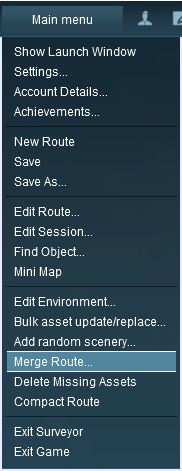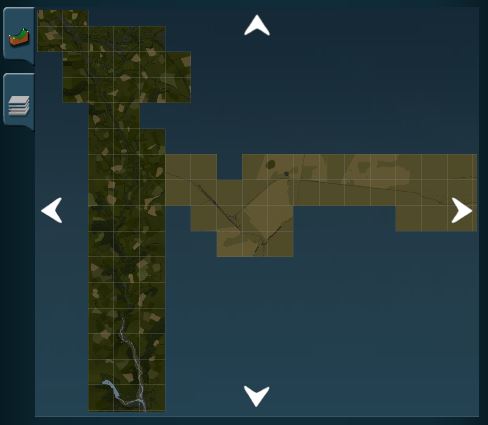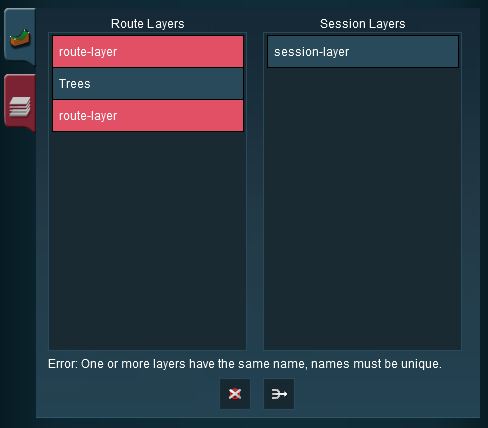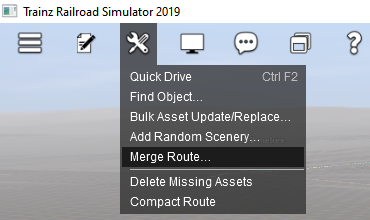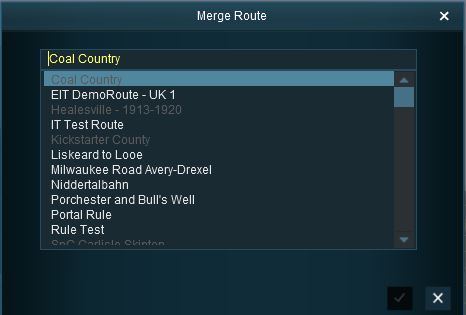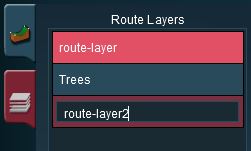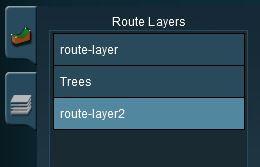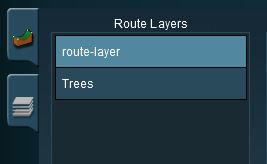Merging Routes
The information in this Wiki Page applies to TANE, TRS19 and Trainz Plus.
The Surveyor Merge Routes command allows two different routes to be joined together edge-to-edge or end-to-end.
Before You Start Merging
 |
Make sure that you have backup copies of all the routes that you are going to merge. |
Before you start merging there are some important points you will need to consider and there may be some preparation work that will have to be performed.
 |
Identify...
- the route that will be the base route. This route will form the backbone of the merged routes. It will usually be the larger route or the route that contains Session data that you want to keep in the merge.
- the route that will be the to-be-merged route. This route will be joined to the base route.
- the orientation (North-South or East-West) of both routes. Are they both the same or are they different?
- the baseboards in both routes where they will be joined. The join must be along edges with no overlaps.
- the height of the baseboards in both routes at the merge point. Are they the same height or different heights?
- any layers in the two routes that have the same name.
- which layers in both routes contain the tracks and the track objects (signals, switches, speed signs, etc).
|
File Sizes and Available Storage
 |
The success of the merging process will depend on the size of the two routes being merged and the size of your systems available memory |
The merging process occurs within your computers on-board memory (RAM). If this is insufficient then your system will also use virtual RAM, i.e. your disk storage space as temporary memory, which is significantly slower. If your system does not have enough memory, both on-board and virtual, then merging large routes will become a problem (i.e. impossible or will take a very long time).
The forums contain several examples of merge attempts involving very large routes (each several hundred Megabytes in size) taking days to complete or failing to complete at all. In some of these cases the users had insufficiant RAM (on-board and virtual) installed in their system. In one documented case, doubling the available on-board RAM from 16GB to 32GB and increasing the Windows virtual memory page size (disk based or virtual RAM) reduced the merge time for two extremely large routes from over 50 hours to 10 hours.
Common Problems (and Their Solutions)
 |
Most route mergers will have problems but most of these problems can be easily fixed. |
Some problems will require you to do a bit (or a lot) of extra work before you can merge two routes into one. But for some problems, the best solution may be to select other routes to merge.
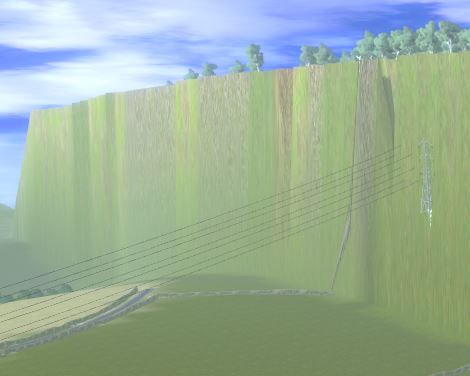
- The easiest and most common problems will be fixed during the merging process itself.
- Sometimes textures from the base route will bleed into the to-be-merged route particularly if the latter route is not textured. The solution to this can be found in the Trainz Wiki
 How to Use Bulk Asset Update/Replace Tool. How to Use Bulk Asset Update/Replace Tool.
- The most common problem in the "hard to fix but do-able" category is merging two routes that have been built at different heights or altitudes. This will create a vertical cliff along the merge line, as shown on the left. The solutions to this will vary depending on the height difference. Common solutions are:-
- add extra baseboards between the two routes to create an easy gradient between them. See the "Tips" box below. If the height difference is large then many additional baseboards will be needed. If the difference is too big then other options may have to be considered.
- use a spiral tunnel or switchback/zigzag to build track between the two levels. This will reduce number of extra baseboards.
- add portals to both routes so that a consist entering the portal on one route will emerge from the portal on the other route. Portals can have their own issues and this solution may not suit everyone and every layout.
|
- Another fixable problem can occur if a layer containing track from the to-be-merged route ends up below the layer that also contains track in the base route. This can be fixed by merging the lower track layer into the higher track layer either during the merging process or afterwards using the
 Layer Tools in Surveyor. Layer Tools in Surveyor.
|
 |
The most common problem in the "impossible to fix" category is when both routes have different orientations (N-S and E-W) and you were hoping to join them end-to-end in the same direction to make an even longer route. Once a route has been created its orientation cannot be changed. |
 |
A handy tip for merging two routes with different heights is to create a new route that only contains the extra "in-between" baseboards - no scenery, textures or track are needed. The baseboards on one end will have heights that match those of the base route and the baseboards on the other end will have heights that match those of the to-be-merged route. The merge is performed in two stages:-
- the new bridging route is merged with the Base route.
- the selected to-be-merged route is merged with the Base + bridging route.
This avoids having to add the extra baseboards to the original routes. |
Selecting and Loading the Routes to Merge
 Load the Base Route into Surveyor
Load the Base Route into Surveyor
 |
Should you load the Route or the Session?
The answer depends on whether or not the Session contains assets (scenery, consists) and settings (rules, driver commands, industry and wagon loads, weather, time of day, etc) that you want to continue to use in the new merged Route and its Session. If this is the case then load the Session. If the Session contains nothing that you need, then only load the Route.
Note that when you add the to-be-merged route its Route assets and data will be loaded but not any Session assets or data so this is the only opportunity you will have to load any Session assets and data. If the Session attached to the Base Route contains nothing that you need then load the Route only into Surveyor.
|
 Start the Merge Route Tool and select and load the Route to-be-merged with the Base Route.
Start the Merge Route Tool and select and load the Route to-be-merged with the Base Route.
This will display a "minimap" of the proposed merger (nothing will be merged until after the final step) with some control options.
The Merge Map
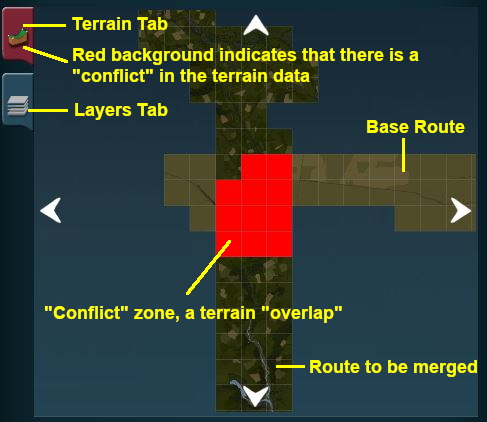 |
The two tabs shown on the left are the:-
- Terrain Tab which is automatically selected when the MiniMap is first displayed. This shows the baseboards of the to-be-merged route superimposed on the baseboards of the base route. A red background colour on this tab, as shown in the figure on the left, indicates that the two routes have baseboards that are in conflict - they are overlapping. The overlapping baseboards are shown in red on the MiniMap.
- Layers Tab. This shows the layers that have been copied from both routes. A red background colour on this tab indicates that the two routes have layers that are in conflict.
 |
Notes:
- You can zoom the MiniMap in and out using the mouse control wheel. There appears to be no keyboard zoom control.
- You can move the centre of focus (the centre of the MiniMap view) by moving the mouse pointer to a new position and clicking with the right button.
- The four arrows shown at the top, bottom and both sides of the map display can be clicked to move the to-be-merged route in the direction shown by each arrow.
|
|
Move the To-Be-Merged Route into its New Position
The Layers Map
Click the Layers Tab to show the layers loaded from the two routes.
 |
A route merge will not proceed until ALL the terrain and layer conflicts have been eliminated. |
In the example shown below two of the layers, one from each route, are using the same name "route-layer". This causes a conflict that must be resolved before the merge can be completed.
There are three simple options for solving this problem:-
 |
Rename one of the conflicting layers. Double click on the layer name to enter a new name. |
 |
Delete one of the conflicting layers. Select the layer and click on the Delete icon. |
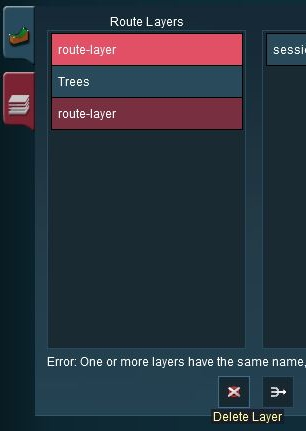 |
 |
CAUTION: Deleting a layer will delete all its contents. |
After clicking the Delete Icon ...
... the conflict has now been resolved. |
 |
Merge one of the conflicting layers. |
|
 |
Steps:
- Select the layer that is to be merged
- Click on the Merge icon (next to the Delete Icon)
This will open a list of layers (shown below). |
|
Accept or Reject
Once all the conflicts have been resolved, the final step in the merging process can take place.
 |
ACCEPT: Click to accept the merge. This icon will not be clickable unless ALL conflicts have been resolved. |
 |
REJECT: Click to reject the merge. The merging will be cancelled, no routes will be lost or altered. |
Trainz Wiki
 |
More Tutorials and Guides to Using Trainz
|
Load the Base Route into Surveyor

Start the Merge Route Tool and select and load the Route to-be-merged with the Base Route.
